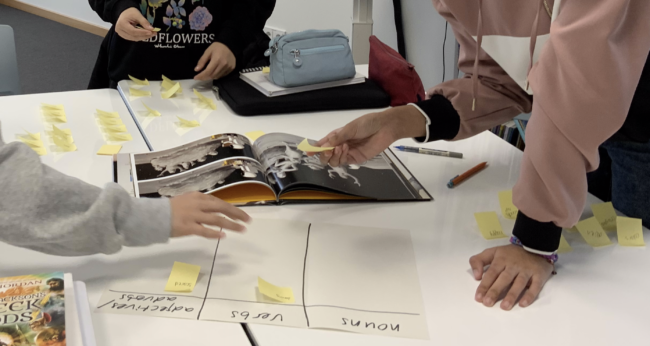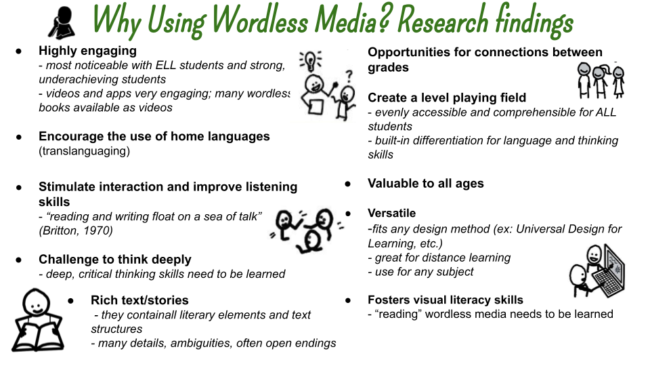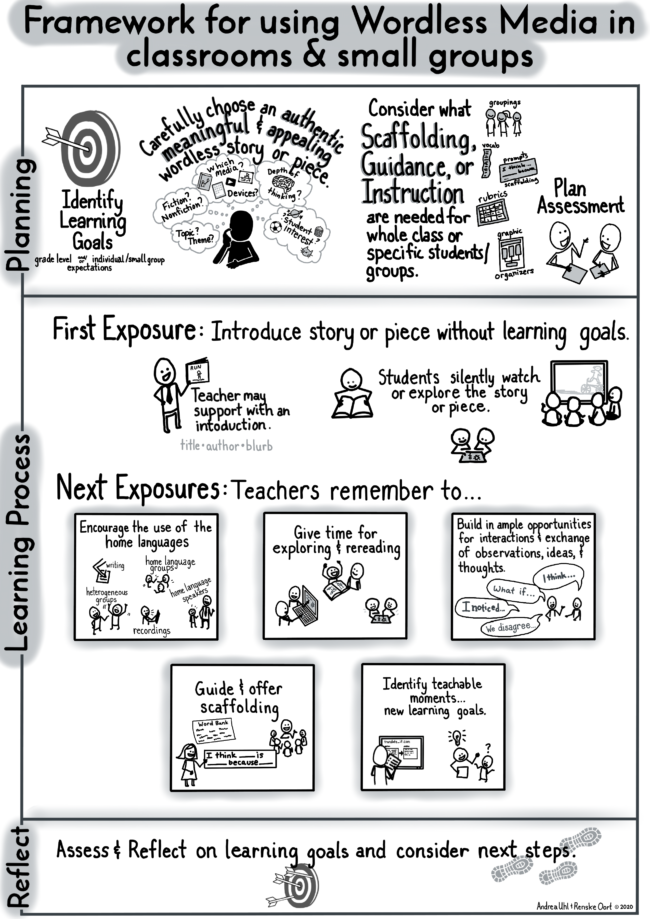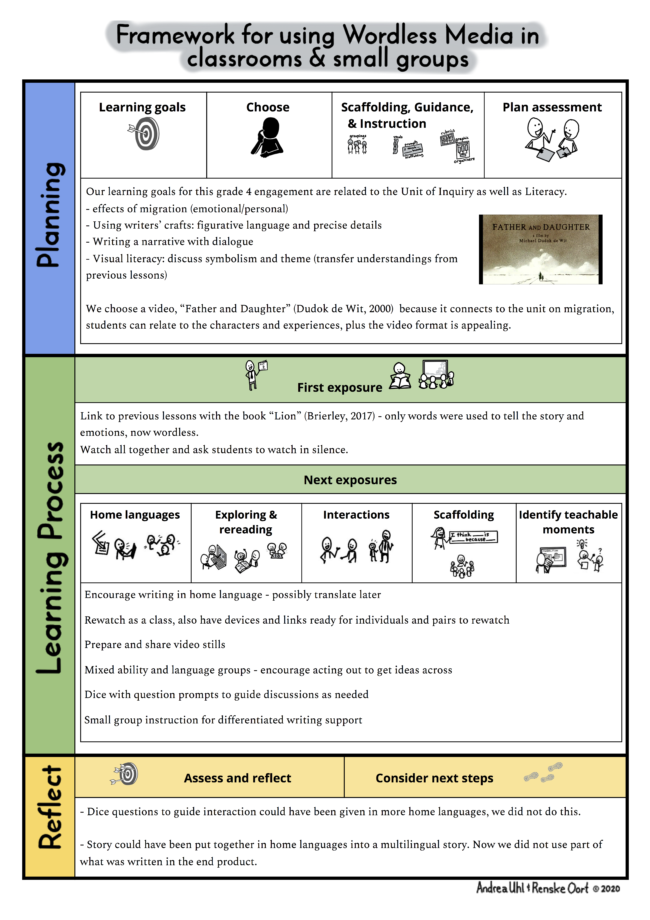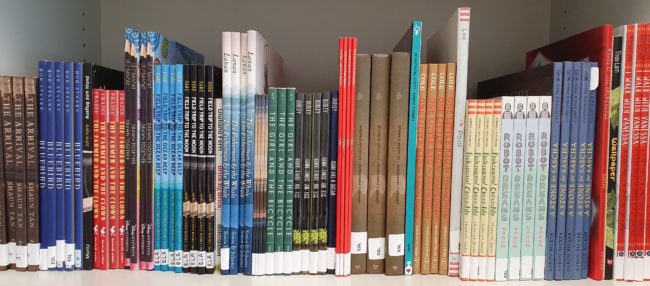This guest blog is written and composed by three teachers from Frankfurt International School Wiesbaden (FISW), Renske Oort, Andrea Uhl and Megan Dreher. FISW is an international school with students from age 3 to grade 8 with a mixed proficiency in English, ranging from students for whom English is their home language to entering and emerging ELL’s. Therefore all mainstream teachers are aware that they are ELA teachers at the same time. This means that ELA students are guided by both classroom and specialised ELA teachers, in the classroom as well as in pull out groups. Homeroom and ELA teachers, like Andrea and Megan, work closely together in planning, teaching, and assessing.
In this blog Renske, Andrea and Megan show the possibilities of improving (language) education by using wordless media such as books and videos to provide students with opportunities to learn and think deeply. In the podcast, you will hear an interview with Megan Dreher.
Tip: If this is the first time that you are working with wordless media in your ELA classroom, start with a mini-lesson with a wordless book such as shown in the first examples (Part 3, A and B). Gradually you can expand to lesson series, where you can use the full potential of wordless media.
Table of contents:
- Part 1 Our experiences – with a short overview of the research, the events which led to it, and how the outcomes were applied.
- Part 2 How to get started – framework plus example
- Part 3 Impressions of lessons and lesson series
- Part 4 Wordless media list – some recommendations
- Part 5 References and suggestions for further reading
Part 1 Our experiences
Renske Oort
When Grade 4 students at FISW watched the video ‘Father and Daughter’ (Dudok de Wit, 2000) in connection with a unit on Migration, they were both amazed and enchanted by the story. But for English language learner Jenny, it meant even more: it was the first time since her arrival earlier in the school year that she understood what the story was about and that she could participate in the lesson. The reason? The video was wordless.
Jenny was eager and able to join the group discussion that followed because she had the pictures of the story fresh in her head and her classmates mimicked cycling up a mountain against the wind, to visualize what they wanted to say. Along the way her vocabulary increased. Then the class wrote a text with an image from the story. Jenny was encouraged to write in her home language, so she wrote and wrote and wrote. At the end of the lesson, she had a big smile on her face.
In 2019, with guidance from teachers Andrea Uhl and Renske Oort, Grade 4 students started to explore what possibilities wordless media such as books and videos could offer to further improve learning in their multilingual classrooms, both in literacy lessons and those connected to the Units of Inquiry.
A selection of wordless books and videos was carefully chosen to be authentic, meaningful and appealing to the students. Ms. Uhl and Ms. Oort prepared the instruction and scaffolding that the whole group or specific students would need: vocabulary, thinking and writing prompts and other materials. Students were given time for exploring, looking slowly and closely, and ‘rereading’, and they had ample opportunities for interaction and exchange of observations, ideas, thoughts and interpretations. Interaction with peers is key for language development, and as author of “Language and Learning” James Britton suggests: “reading and writing float on a sea of talk”.
- Wordless media are engaging, encourage the use of home languages, stimulate interaction and challenge to think deeply
Throughout the whole process, students were encouraged to use their home languages to discuss and write about the various wordless media. In comparison with normal texts, it turned out that using wordless media not only engaged the students more, it also stimulated interaction and improved the language skills of English language learners, while challenging all students to think deeply. The students noted that the fiction and non-fiction wordless media were inspiring, fun and interesting. “It helps me understand more,” an ELL student said. And several students noted: “It makes us think more.” As Jenny described it: “When there are no words, you can think more ideas. I learn English, but I learn thinking, too.”
- Wordless media are rich texts
Wordless stories tell the whole story without words, including emotions, character traits, meanings and themes. FISW Middle School English teacher Scott Hardgrove, who just used a wordless book in a Grade 6 poetry unit, points out: “Even wordless books that seem to be meant for younger students contain a lot of symbolism. The ‘readers’ need to understand and interpret the text structure, symbolism, open endings,” he says. For this they use the same processes in the brain as they do with normal texts. In non-fiction pieces, too, they need to explore and ‘reread’ to understand what is going on.
- Wordless media offer opportunities for connections between grades and create a level playing field
With the guidance of librarian Natasha Pollock, during Information Literacy, Middle School students thoroughly explored wordless books. Then they selected their favourite book to share with younger students through Zoom. Ms Pollock: “The wordless books offer great opportunities for connections between grade levels.”
Ms.Uhl adds: “Wordless stories are evenly accessible and comprehensible for all students. They provide built-in differentiation possibilities for language and thinking skills.” In other words, they create a level playing field in our multilingual classrooms with mixed proficiencies.
- Wordless media are valuable for all ages and versatile
Visuals as a support in content learning and the Units of Inquiry are seen regularly in the lower grades, but they are just as valuable in the higher grades of Elementary school and Middle and Upper school, according to Soledad Chinchilla, FISW ELA and Spanish teacher.
Megan Dreher, who teaches ELA, uses wordless books often to make connections with the units in the homerooms, with sentence starters for the emerging English language learners. “They are excellent for Universal Design for Learning and also easy to use in distance learning and with tools such as Voicethread, Seesaw, Google Classroom and Jamboard. I have developed an addiction, there are so many beautiful wordless books and videos. Look at the new ones I found!”
- Wordless media make ‘readers’ look AND listen better
In the meantime, Jenny chose to use wordless stories in her Grade 5 Exhibition project and discovered another advantage: “Because there are no words, the people cannot read, so they have to listen to me.” The stories may be wordless, but the students are less and less speechless.
Part 2 How to get started: framework + example
To access a blank framework to help you plan, please use the provided link. Here’s a worked example to help with your planning.
Part 3 Impressions of lessons and lesson series
Renske Oort, Megan Dreher and Andrea Uhl
- Collection examples ELA emerging groups: link
- Examples of multilingual lessons in literacy and units of inquiry: link
Part 4 Wordless media list – some recommendations
Please remember:
- Because wordless media are often rich texts and versatile, the categories Lower/Primary, Elementary, Middle and Upper School do not have to be followed strictly.
- Many books are available as a wordless video too.
Lower/Primary School
Books
- Wallpaper by Thao Lam – Friendship, Belonging, Imagination
- Red Hat by Lita Judge – Responsibility, Ownership, Choices
- Daisy Gets Lost by Chris Raschka – Facial expressions, Fear
- Flora and the Penguin by Molly Idle – Communication, Dance, Habitats
- Flora and the Flamingo by Molly Idle – Communication, Body language, Friendship
- Hank finds an Egg by Rebecca Dudley – Responsibility, Respect, Nature
Videos
- Burrow (Disney/Pixar) – Home, Community
- Ormie the pig (Arc Productions) – Problem solving
- Pat a Mat series (Lubomír Beneš and Vladimír Jiránek) – Problem solving, Simple machines
Apps
- The Everything Machine (Tinybop) – Coding, Cause & Effect
- Imagistory (Imagistory Publishing)
Elementary School
Books
- Field Trip to the Moon by John Hare – Communication, Problem-solving
- One Little Bag by Henry Cole – Loss, Family, Memories
- The Farmer and the Clown by Marla Freeze – Communication, Differences
- A Stone for Sasha by Aaron Becker – Loss, Connection, Memories
- I Walk with Vanessa by Kerascoet – Bullying, Friendship, Community
- Here I Am by Patti Ki – Migration, Courage, Home Belonging, Culture, Friendship
- Bluebird by Bob Starke – Responsibility, Loneliness, Bullying, Friendship
- Sidewalk Flowers by Jon Arno Lawson and Sidney Smith – Kindness
- Professional Crocodile by Giovanna Zoboli and Mariachiara di Giorgio – Professions, Routines, Expectations
- The Girl and the Bicycle by Mark Pett – Persistence, Money
Videos
- Father and Daughter by Michael Dudok de Wit – Time, Family, Loss, Migration
- Float (Pixar/Disney) – Acceptance, Shame, Uniqueness
- Loop (Pixar/Disney) – Autism, Point of View
- Piper (Pixar/Disney) – Courage, Problem solving
- This Too Shall Pass by OK Go Sandbox – Simple Machines, Energy (note: this is not wordless as there are lyrics but it does not impact the science concepts)
- Any other videos by OK Go Sandbox videos
App
- Radio Jones and his Robot Dad by Nexus Productions – Family, Improvement
- Human Body by Tinybop – Human Body, Interaction, Interdependence .
- Any other apps by Tinybop
Middle and Upper School
Books
- The Arrival by Shaun Tan – Migration, War, Assimilation
- Robot Dreams by Sara Varon – Friendship, Loss, Redemption
- The Wanderer by Peter Van Den Ende – Growing, Learning
- Ovni by Fabrice Parme – Cause & Effect, History
- A Sea of Love by Wilfrid Lupano and Grégory Panaccione – Love, Devotion
Videos
- Father and Daughter by Michael Dudok de Wit – Time, Family, Loss, Migration
- The Fish by PES videos – Pollution, Environment Impact, Food Chain/Web
- Moth by PES videos – Food Chain, Life, Animation
- Float (Pixar/Disney) – Acceptance, Shame, Uniqueness
- Bao (Pixar/Disney) – Family, Adolescence, Independence, Dependence
- The One Moment by OK GO Sandbox – Algebra, Gravity, Flipbooks
- Any other videos and lessons by OK Go Sandbox for more concepts.
More recommendations:
- Wordless game for all ages: Dixit (Asmodee)
- Wonderfully wordless: the 500 most recommended graphic novels and picture books, by W.P. Martin (2015)
- You may also find that some, certainly not all, media pieces can have the words or sound removed. If you choose to do this, it is not recommended to reveal the original sound or texts as students may feel their ideas were “wrong”.
For more suggestions on books and videos and how to use them, you can also contact the authors of this blog.
Author bios
Renske Oort is an elementary school teacher (teaching home language Dutch) and student learning coach. She recently graduated with an Educational Needs Master’s degree. The research for her thesis on wordless media was the basis for the journey described in this blog. (Email: renske_oort@fis.edu)
Andrea Uhl is an educator and artist. She has over 10 years of elementary classroom teaching experience and is passionate about supporting students to become active thinkers and lifelong learners. (Email: andrea_uhl@fis.edu)
Megan Dreher is an ELA teacher. She has taught high school computers, middle school English and was an elementary homeroom teacher. She believes in providing students with opportunities to speak and learn in authentic and meaningful contexts. (Email: megan_dreher@fis.edu)
Part 5 References and suggestions for further reading
On wordless and visual media:
Arizpe, E. (2013). Meaning-making from wordless (or nearly wordless) picturebooks: what educational research expects and what readers have to say. Cambridge Journal of Education, 43(2), 163-176.
Bang, M. (2016). Picture this: how pictures work. San Francisco, CA: Chronicle Books.
Cohn, N., Jackendoff, R., Holcomb, P. J., & Kuperberg, G. R. (2014). The grammar of visual narrative: Neural evidence for constituent structure in sequential image comprehension. Neuropsychologia, 64, 63-70.
Jalongo, M. R., Dragich, D., Conrad, N. K., & Zhang, A. (2002). Using wordless picture books to support emergent literacy. Early Childhood Education Journal, 29(3), 167-177.
Louie, B., & Sierschynski, J. (2015). Enhancing English learners’ language development using wordless picture books. The Reading Teacher, 69(1), 103-111.
Serafini, F. (2014a). Exploring wordless picture books. The Reading Teacher, 68(1), 24-26.
Serafini, F. (2014b). Reading the visual: An introduction to teaching multimodal literacy. New York, NY: Teachers College Press.
Walsh, M., Cranitch, M., & Maras, K. (2012). Into the deep end: The experience with Flotsam in Australia, TESOL in Context, 1-16. Retrieved February 11, 2019, from http://www.tesol.org.au/files/files/247_maureen_walsh.pdf
Smith, G. G. (2003). Stimulating critical thinking with wordless books. Ohio Reading Teacher, 36(1/2), 75-80.
On visible and deep thinking and slow looking:
Harvard Graduate School of Education. (2016). Visible thinking. Retrieved January 6, 2019, from http://www.pz.harvard.edu/projects/visible-thinking
Ritchhart, R. (2015). Creating cultures of thinking: The 8 forces we must master to truly transform our schools. San Francisco, CA: Jossey-Bass.
Tishman, S. (2018). Slow looking: The art and practice of learning through observation. New York, NY: Routledge.
On scaffolding; background and resources:
Calkins, L. (2015). Reading Pathways: Performance Assessments and Learning Progressions, Grades 3–5. Portsmouth, NH: Heinemann.
Gibbons, P. (2015). Scaffolding language, scaffolding learning: teaching English language learning in the mainstream classroom. Portsmouth, NH: Heinemann.
Serravallo, J. (2015). The reading strategies book: your everything guide to developing skilled readers. Portsmouth, NH: Heinemann.
Wordless books and videos used in the blog and the examples:
Barillaro, A., Sondheimer, M., Lasseter, J., & Stanton, A. (2016). Piper [Video file]. Retrieved January 23, 2021, from https://vimeo.com/341077341
Dudok de Wit, M. (2000). Father and daughter [Video file]. Retrieved April 14, 2018, from https://youtu.be/CvA4Gn5OudI
Gu, M. (2017, May 10). The lonely kid: a short film [Video file]. Retrieved March 13, 2019, from https://youtu.be/WQlHw8sIPRo
Hare, J. (2019). Field trip to the moon. New York, NY: Margaret Ferguson Books.
Hare, J. (2020, March 24). Grey (Field trip to the moon) [Video file]. Retrieved February 7, 2020, from https://youtu.be/_MGGsacZYkg
Kim, P., & Sánchez, S. (2015). Here I am. North Mankato, MN: Capstone.
Mr Baker’s bookshelf. (2017). Flotsam by Wiesner [Video file]. Retrieved January 23, 2021, from https://youtu.be/3MTKWnxzqvM
Newman, J. (2010). The boys. New York, NY: Simon and Schuster.
Nexus Productions (2016). Radio Jones and his robot dad [App]. Retrieved January 23, 2021, from https://apps.apple.com/gb/app/radio-jones-and-his-robot-dad/id969003554
OK Go Sandbox. (2019). This too shall pass [Video file]. Retrieved June 24, 2019, from https://okgosandbox.org/this-too-shall-pass
Wiesner, D. (2006). Flotsam. New York, NY: Clarion/Houghton Mifflin.

